DARWIN, Charles Robert (1809-1882). Narrative of the Surveying Voyages of His Majesty's Ships Adventure and Beagle . Edited by Robert FITZROY (1805-1865). London: J.L. Cox and Sons [volumes I-II and Appendix ] and Whiting [volume III] for Henry Colburn, 1839. 4 volumes including Appendix , 8° (235 x 145mm). Half-titles. Engraved frontispieces to volumes I-III by P.P. King and Conrad Martens after T. Landseer. 44 etched plates and engraved plans by C. Martens after T. Landseer, and others, one engraved folding map by J. Gardner, 8 engraved maps loosely inserted in wallets on the upper boards. Woodcut illustrations. (Occasional light spotting and offsetting, plates spotted, inserted maps with minor tears on folds, one neatly reinforced on folds, another with small losses and skilfully silked.) Original dark-blue cloth [volumes I-II with authors' names on spines and imprint 'LONDON , COL BURN', Appendix and volume III Freeman variant a], sides panelled in blind, spines lettered in gilt, (extremities a little rubbed, skilfully recornered and rebacked preserving original backstrip). Provenance : early inscription dated 1840 on pastedown of Appendix . FIRST EDITION, CONTAINING DARWIN'S FIRST PUBLISHED BOOK ( JOURNAL AND REMARKS 1832-1836 ), HIS ACCOUNT OF THE VOYAGE THAT WAS 'THE MOST IMPORTANT EVENT IN HIS INTELLECTUAL LIFE' ( DSB III, p.566). In 1831 John Stevens Henslow, Darwin's friend and mentor as a naturalist, persuaded the Admiralty to invite Darwin to join the Beagle on its survey of South America. Darwin's father was against the trip, but Darwin's uncle, Josiah Wedgewood II, persuaded him to allow Darwin to join the ship, and Darwin sailed aboard the Beagle on 27 December 1831. As DSB records, 'the five years of the voyage were the most important event in Darwin's intellectual life and in the history of biological science. Darwin sailed with no formal scientific training. He returned a hard-headed man of science, knowing the importance of evidence' (p.566). Darwin's studies concentrated initially on geology, applying the theories proposed by Sir Charles Lyell in his Principles of Geology (a copy of which he carried with him). Darwin studied the formation of coral reefs according to Lyell's theory, but realised that this hypothesis could not be supported by the evidence, and proposed an alternative, which was published as The Structure and Distribution of Coral Reefs. Being the first Part of the Geology of the Voyage of the Beagle ... (London: 1842), which 'still remains the standard explanation, except for a slight addition' ( DSB III, p.569). However, the greatest importance of the voyage lay in Darwin's desire to understand and explain the distribution and development of the species he encountered: he returned, 'almost convinced that species had not always been as they were since the creation, but had undergone change [...] The experiences of his five years in the Beagle , how he dealt with them, and what they led to, built up into a process of epoch-making importance in the history of thought' ( DSB III, p.566). The only plausible hypothesis seemed to be his theory of evolution, which was first published in 1858 as 'On the Tendency of Species to Form Varieties' (London: 1858, see following lot), and initiated the debate on evolution. Freeman 10; Hill Pacific Voyages pp.104-105; Norman 584; Sabin 37826. (4)
DARWIN, Charles Robert (1809-1882). Narrative of the Surveying Voyages of His Majesty's Ships Adventure and Beagle . Edited by Robert FITZROY (1805-1865). London: J.L. Cox and Sons [volumes I-II and Appendix ] and Whiting [volume III] for Henry Colburn, 1839. 4 volumes including Appendix , 8° (235 x 145mm). Half-titles. Engraved frontispieces to volumes I-III by P.P. King and Conrad Martens after T. Landseer. 44 etched plates and engraved plans by C. Martens after T. Landseer, and others, one engraved folding map by J. Gardner, 8 engraved maps loosely inserted in wallets on the upper boards. Woodcut illustrations. (Occasional light spotting and offsetting, plates spotted, inserted maps with minor tears on folds, one neatly reinforced on folds, another with small losses and skilfully silked.) Original dark-blue cloth [volumes I-II with authors' names on spines and imprint 'LONDON , COL BURN', Appendix and volume III Freeman variant a], sides panelled in blind, spines lettered in gilt, (extremities a little rubbed, skilfully recornered and rebacked preserving original backstrip). Provenance : early inscription dated 1840 on pastedown of Appendix . FIRST EDITION, CONTAINING DARWIN'S FIRST PUBLISHED BOOK ( JOURNAL AND REMARKS 1832-1836 ), HIS ACCOUNT OF THE VOYAGE THAT WAS 'THE MOST IMPORTANT EVENT IN HIS INTELLECTUAL LIFE' ( DSB III, p.566). In 1831 John Stevens Henslow, Darwin's friend and mentor as a naturalist, persuaded the Admiralty to invite Darwin to join the Beagle on its survey of South America. Darwin's father was against the trip, but Darwin's uncle, Josiah Wedgewood II, persuaded him to allow Darwin to join the ship, and Darwin sailed aboard the Beagle on 27 December 1831. As DSB records, 'the five years of the voyage were the most important event in Darwin's intellectual life and in the history of biological science. Darwin sailed with no formal scientific training. He returned a hard-headed man of science, knowing the importance of evidence' (p.566). Darwin's studies concentrated initially on geology, applying the theories proposed by Sir Charles Lyell in his Principles of Geology (a copy of which he carried with him). Darwin studied the formation of coral reefs according to Lyell's theory, but realised that this hypothesis could not be supported by the evidence, and proposed an alternative, which was published as The Structure and Distribution of Coral Reefs. Being the first Part of the Geology of the Voyage of the Beagle ... (London: 1842), which 'still remains the standard explanation, except for a slight addition' ( DSB III, p.569). However, the greatest importance of the voyage lay in Darwin's desire to understand and explain the distribution and development of the species he encountered: he returned, 'almost convinced that species had not always been as they were since the creation, but had undergone change [...] The experiences of his five years in the Beagle , how he dealt with them, and what they led to, built up into a process of epoch-making importance in the history of thought' ( DSB III, p.566). The only plausible hypothesis seemed to be his theory of evolution, which was first published in 1858 as 'On the Tendency of Species to Form Varieties' (London: 1858, see following lot), and initiated the debate on evolution. Freeman 10; Hill Pacific Voyages pp.104-105; Norman 584; Sabin 37826. (4)
.jpg)

.jpg)
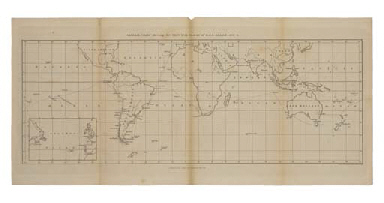
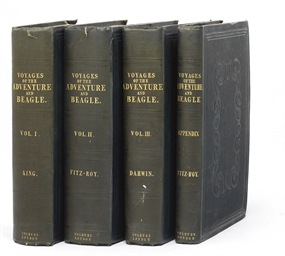
.jpg)

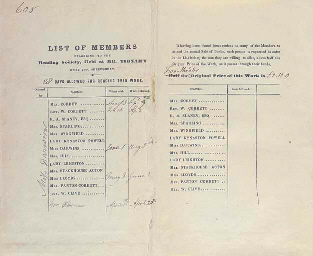


.jpg)
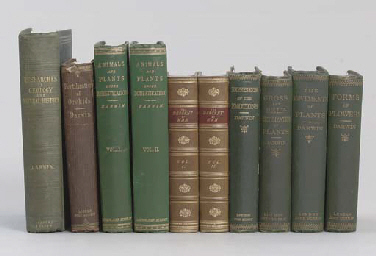


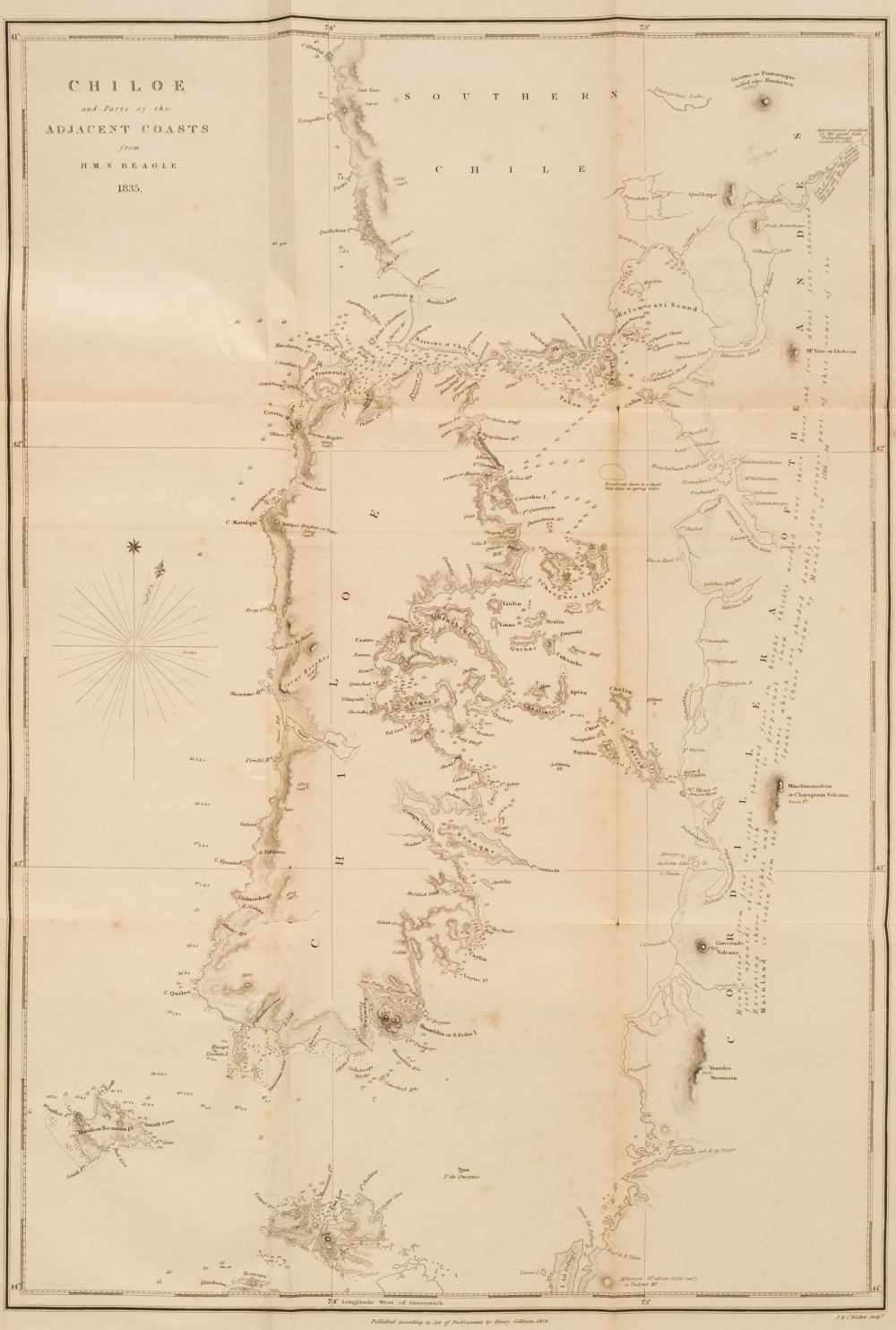
Testen Sie LotSearch und seine Premium-Features 7 Tage - ohne Kosten!
Lassen Sie sich automatisch über neue Objekte in kommenden Auktionen benachrichtigen.
Suchauftrag anlegen